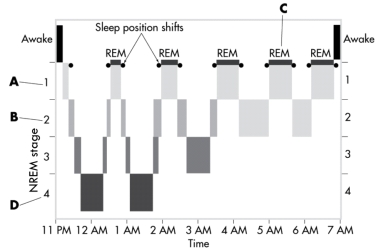This image depicts the sleep cycles over the course of a typical night. In which stage does the brain become much more active, and heart rate, blood pressure, and respirations shift up and down, sometimes extremely? 
Definitions:
Fechner's Law
A principle describing the relationship between the intensity of a stimulus and the magnitude of the sensory experience, stating that the intensity must increase geometrically to produce a linear increase in perception.
Sensory Adaptation
The mechanism where sensory receptors reduce their responsiveness to stimuli that remain constant over time.
Weber's Law
A principle in psychology that states the smallest perceptible difference in a stimulus is proportional to the intensity of the original stimulus.
High Threshold
A term indicating a level of high sensitivity or resistance to stimulus before a response is triggered.
Q29: Amphetamines are widely used today to control
Q80: Brandy is fond of attending all-night raves
Q80: The bipolar cells funnel raw data from
Q111: Transcendental meditation is a form of meditation
Q113: Sensory receptors respond only when stimulated by
Q140: The figure-ground relationship refers to the automatic
Q147: Myopia is another name for the farsightedness
Q162: Caleb had a wonderful time on his
Q185: In using operant conditioning principles to train
Q224: Sleep disorders involving undesirable physical arousal, behaviors,